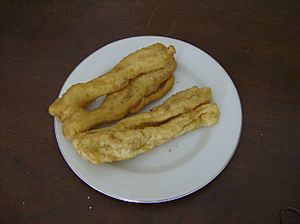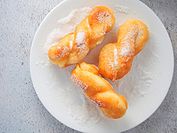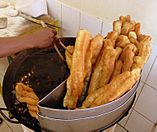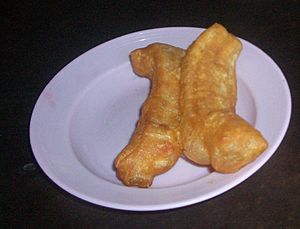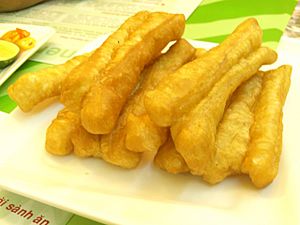Youtiao facts for kids
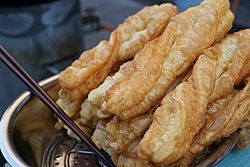
Pieces of youtiao
|
|
| Alternative names | Chinese cruller |
|---|---|
| Type | Doughnut |
| Course | Breakfast |
| Region or state | Guangdong |
| Serving temperature | Fried |
| Main ingredients | Dough |
| Youtiao | |||||||||||||||||||||||
|---|---|---|---|---|---|---|---|---|---|---|---|---|---|---|---|---|---|---|---|---|---|---|---|
| Chinese name | |||||||||||||||||||||||
| Traditional Chinese | 油條 | ||||||||||||||||||||||
| Simplified Chinese | 油条 | ||||||||||||||||||||||
| Literal meaning | oil strip | ||||||||||||||||||||||
|
|||||||||||||||||||||||
| Yu Char Kway | |||||||||||||||||||||||
| Traditional Chinese | 油炸粿/餜/鬼 | ||||||||||||||||||||||
| Simplified Chinese | 油炸粿/馃/鬼 | ||||||||||||||||||||||
| Literal meaning | oil-fried pastry (or devil) | ||||||||||||||||||||||
|
|||||||||||||||||||||||
| Guozi | |||||||||||||||||||||||
| Traditional Chinese | 餜子 | ||||||||||||||||||||||
| Simplified Chinese | 馃果 | ||||||||||||||||||||||
| Literal meaning | pastry | ||||||||||||||||||||||
|
|||||||||||||||||||||||
| Burmese name | |||||||||||||||||||||||
| Burmese | အီကြာကွေး Ee Kyar Kway |
||||||||||||||||||||||
| Vietnamese name | |||||||||||||||||||||||
| Vietnamese | dầu cháo quẩy / giò cháo quẩy | ||||||||||||||||||||||
| Thai name | |||||||||||||||||||||||
| Thai | ปาท่องโก๋ | ||||||||||||||||||||||
| RTGS | pathongko | ||||||||||||||||||||||
| Malay name | |||||||||||||||||||||||
| Malay | Cakoi چاکوي |
||||||||||||||||||||||
| Indonesian name | |||||||||||||||||||||||
| Indonesian | cakwe | ||||||||||||||||||||||
| Filipino name | |||||||||||||||||||||||
| Tagalog | bicho-bicho/shakoy | ||||||||||||||||||||||
| Khmer name | |||||||||||||||||||||||
| Khmer | ឆាខ្វៃ / យ៉ាវឆាខ្វៃ Chha Khwai / Yav Chha Khwai |
||||||||||||||||||||||
Youtiao (simplified Chinese: 油条; traditional Chinese: 油條; pinyin: Yóutiáo) is a long, golden-brown strip of fried dough. It is made from wheat flour. This tasty snack first became popular in China.
You can find youtiao (also called Yu Char Kway in Southern China) in many other parts of East Asia and Southeast Asia. People often eat it for breakfast. It is usually lightly salted and can be easily torn into two pieces.
Youtiao is often enjoyed with rice porridge, soy milk, or regular milk mixed with sugar. It has many different names around the world, like Chinese cruller, Chinese fried churro, Chinese oil stick, Chinese doughnut, or fried breadstick. In other Asian countries, it might be called bicho, cakwe, cakoi, kueh, shakoy, or pathongko.
How to Enjoy Youtiao
Youtiao Sandwiches
Youtiao is often used to make delicious sandwiches. For example, it can be stuffed inside shāobǐng (a roasted flatbread). This creates a sandwich called shāobǐng yóutiáo.
Another way to eat it is wrapped in a rice noodle roll. This dish is known as zháliǎng. In Yunnan, a roasted rice flour pancake is often wrapped around a youtiao. This is called erkuai. You can also find a sandwich version called jianbingguǒzi.
Dipping and Other Dishes
Sometimes, youtiao is dipped into different liquids. These can include the soup xidoufen, sweet or salty soymilk, or even soy sauce.
Youtiao is also a key ingredient in a dish from Shanghai cuisine called Cífàn tuán. This is a sticky rice ball.
Tánggāo (sugar cake) is a sweet, fried food. It looks a bit like youtiao but is shorter.
In Thailand, youtiao is called pathongko. People eat it for breakfast with soymilk or porridge.
Names Around the World
China's Names for Youtiao
In most of China, this fried dough is known as yóutiáo. However, in northern China, it is sometimes called guǒzi. In areas where people speak Min Nan (like Taiwan), it is known as iû-chiā-kóe. This name means "oil-fried cake or pastry."
In Cantonese-speaking places, like Hong Kong, it is called yàuh ja gwái. This name literally means "oil-fried devil" or "oil-fried ghost."
The Story Behind the Name
There is a folk story about the Cantonese name yàuh ja gwái. It is said to be a protest against a disliked official from the Song dynasty named Qin Hui. People believed he caused trouble for a respected general, Yue Fei.
The food was originally shaped like two human figures. Later, it became two pieces of dough joined in the middle. These two pieces were said to represent Qin Hui and his wife. People would deep-fry and eat the youtiao as if they were doing it to the disliked couple. This story shows how people felt about them.
Cambodia's Cha Kway
In Cambodia, youtiao is called cha kway. People usually dip it in kuy teav (noodle soup), porridge, or coffee. Some Cambodians of Chinese background living in Australia sometimes call it "chopstick cake." This is because it looks like a pair of chopsticks.
Indonesia's Cakwe
In Indonesia, this fried dough is called cakwe. It is often chopped or sliced thin. People eat it for breakfast with bubur ayam (chicken porridge). It is also a popular snack. You can eat it with a local chili sauce or peanut sauce.
In Java, cakwe is often sold by street vendors from small carts called kaki lima. These vendors might also sell bolang-baling (sweet fried dough) and untir-untir (a crunchy twisted snack).
Laos' Patongko
In Laos, youtiao is called kao nom kou or patongko. It is often eaten with coffee for breakfast, instead of a baguette. It also goes well with khao piek sen (chicken noodle soup) or jok (congee).
Malaysia's Cakoi
In Malaysia, it is called cakoi. This name comes from the Minnan term. In northern states like Kedah, Perlis, and Penang, the name pathongko is more common. Cakoi is sold in morning markets or night markets. People usually eat it with coffee or soy milk for breakfast or as a snack in the afternoon.
Singapore's Yu Char Kway
In Singapore, it is known as yu char kway. This is how its Hokkien name (油炸粿 iû-tsiā-kué) sounds. Besides the plain version, Singapore also has youtiao with different fillings. Some are sweet, like red bean paste (called ham chim peng). Others are savory, like sardines in tomato sauce. The plain yu char kway is often eaten with sweet chili sauce or kaya (a coconut and egg jam). It is also served with bak kut teh (pork rib soup) or congee. People often slice it thin and dip it into the soup or porridge.
Myanmar's E Kya Kway
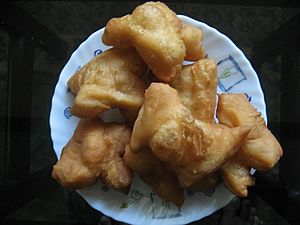
Youtiao is a popular breakfast food in Myanmar (Burma). There, it is called e kya kway. People usually eat it with steamed yellow beans (with salt and oil). They also dip it into coffee or tea. E kya kway is eaten with rice porridge or cut into small rings. It can be used as a topping for mohinga (fish noodle soup).
Tea shops are very common in Myanmar. Almost every shop serves e kya kway for breakfast. Some shops even stuff meat into the youtiao and fry it again. This is called e kya kway asar thoot – stuffed e kya kway.
Philippines' Bicho and Shakoy
In the Philippines, this fried dough is called Bicho / Bicho-Bicho or Shakoy / Siyakoy. Other names include Pinisi or lubid-lubid. Bicho-Bicho is usually deep-fried. Shakoy is deep-fried and twisted, like a twisted doughnut. Smaller, dry, and crunchy versions are called pilipit.
Thailand's Pathongko
In Thailand, youtiao is generally called pathongko. This name came from a misunderstanding with a different dessert. The original pathongko was a white sugar sponge cake. Street vendors used to sell both youtiao and the white sugar cake. They would shout out both names. However, Thai customers often thought the more popular youtiao was "pathongko." Over time, the real pathongko became less popular and disappeared. So, youtiao kept the name "pathongko."
In Thailand, pathongko is also dipped into condensed milk. In the South, it is often eaten with kaya.
Vietnam's Quẩy
In Vietnamese cuisine, it is known as dầu cháo quẩy, giò cháo quẩy, or simply quẩy. These names sound similar to the Cantonese pronunciation. In Vietnam, giò cháo quẩy is typically eaten with congee, pho (noodle soup) in Hanoi, and sometimes with wonton noodles.
See also
 In Spanish: Youtiao para niños
In Spanish: Youtiao para niños


